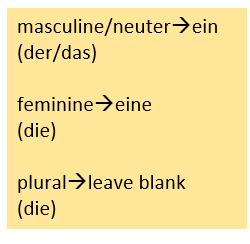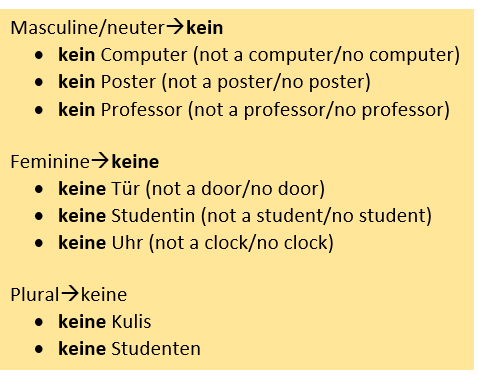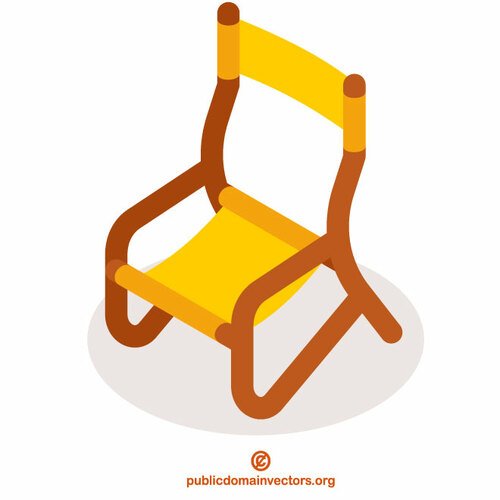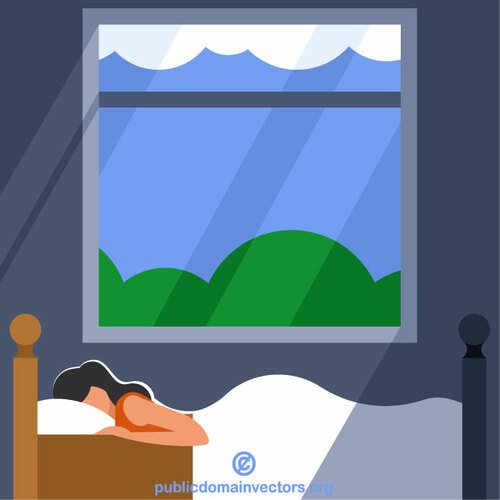9 Section 1-9
1–9: Indefinite Articles (Ein/eine) and “Kein/Keine”
You have already learned the definite article (der/die/das) of each word in this chapter so far. Now we’re going to add indefinite articles.
An indefinite article in English is the word “a” or “an.” In German, you will use “ein” or “eine,” depending on the gender of the noun. This is why it is important to learn the gender along with the noun.

Masculine and neuter add no ending.
Feminine adds an –e to match the end of “die.”
Plural is left blank because you can’t say, for example, “I have a books.” Rephrase to say, “I have books”→Ich habe Bücher.
Beispiele:
- die Schwester→eine Schwester (Feminine adds –e).
- der Bruder→ein Bruder (Masculine adds nothing).
- die Tafel→eine Tafel (Feminine adds –e).
- der Stuhl→ein Stuhl (Masculine adds nothing).
- das Poster→ein Poster (Neuter adds nothing).
- das Handy→ein Handy (Neuter adds nothing).
Video. Click the link to see me reteaching this.
Video. Watch Learn German’s video to see a detailed explanation of indefinite articles.

Ex. A: Was ist das? Practice with your partner, asking what certain items around the room are. This time, you will answer with an indefinite article (ein/eine) instead of a definite article (der/die/das). If you can’t remember the gender of the word, go back and look it up.
A: Was ist das?
B: Das ist ein Fenster.
B: Was ist das?
A: Das ist eine Landkarte.
Ex. B: Ein. Eine. Go to Germanzone.org’s website and do the activity using ein-words and classroom items.

German also has a word to express „not a.“ To negate “ein/eine,” you will use the word “kein” or “keine” in front of the noun, depending on its gender.

COMMON MISTAKE: You may be tempted to say “nicht ein,” (not a), as you would in English. This is incorrect. You should use “kein” or “keine” instead.
INCORRECT: Das ist nicht ein Kuli. INCORRECT!!!
CORRECT: Das ist kein Kuli.
Ex. C: Ist das ein Kuli? Practice with your classmates, using both ein/eine and kein/keine to describe words around the room.
A: Ist das ein Kuli?
B: Nein, das ist kein Kuli. Das ist ein Bleistift.
B: Ist das eine Professorin?
A: Nein, das ist keine Professorin. Das ist eine Studentin.
Ex. D: Ein vs. kein. Go to Germanzone.org’s website to practice ein vs. kein. Each sentence will have two correct answers—one using “ein” and one using “kein.” There may be a few words that you haven’t seen yet, but don’t be afraid to look them up in the dictionary.
Ex. E: Was ist das? Using the pictures below, answer the following questions. Make sure to use both “ein/e” and “kein/e”.
Beispiel:  Ist das ein Buch?
Ist das ein Buch?
→Nein, das ist kein Buch. Das ist ein Heft.
 5.
5. 
Ist das ein Bleistift? Ist das ein Tisch?
2.  6.
6. 
Ist das eine Tür? Ist das eine Landkarte?
3. 7.
7. 
Ist das ein Wischer? Ist das eine Uhr?
4.  8.
8. 
Ist das ein Kuli? Ist das ein Laptop?
Ex. F: Video: Nicos Weg. Folge 3: „Tschüss!“ Watch episode 3 and do the online activities.

